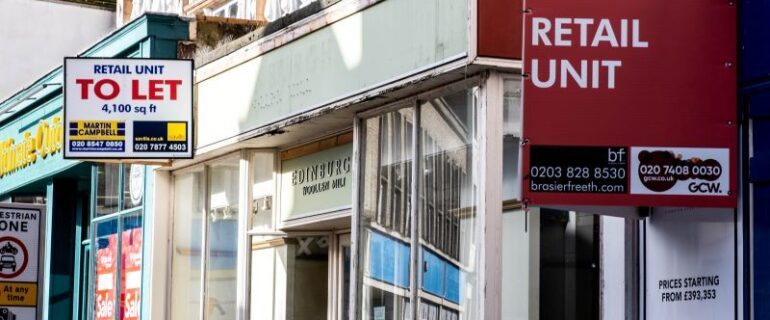As Rachel Reeves’ November Autumn Budget approaches, the effects of last year’s measures are still rippling through the economy.
NerdWallet UK’s latest survey of 500 UK business owners reveals a stark reality: 71% of UK businesses have considered closing down in the past 12 months.
With mass closures of beloved UK chains this year like Poundland, Claire’s and Hobbycraft, it is no secret British businesses are feeling the pinch.
According to NerdWallet UK’s survey, business owners expect to raise prices by an average of 14.5% over the next year just to stay afloat.
While the cost-of-living crisis, and rising employer costs are often blamed, the reasons behind the closures of beloved high street retailers are often far more personal.
Business closures
Top Reasons for Considering Business Closure in the Past 12 Months
| Rank | Top Reasons for Considering Business Closure in the Past 12 Months | Percentage of UK Business Owners (%) |
| 1 | Personal reasons (e.g. health, family) | 34% |
| 2 | Falling customer demand | 31% |
| 3 | Supply chain issues | 30% |
| 4 | Difficulty accessing finance | 29% |
| 5 | Increased rent or property costs | 28% |
| 6 | Staff shortages | 25% |
Our latest survey to UK business owners reveals it is personal reasons like health or family driving UK entrepreneurs to shut their doors for good, with 34% citing this as their main reason for considering shutting down.
After personal reasons, the most common factors were falling customer demand (31%), supply chain issues (30%), and difficulty accessing finance (29%).
Meanwhile, 28% are struggling with increased rent or property costs. Staff shortages were another key factor for a quarter of businesses.
From hospitality to healthcare, the strain stretches across nearly every part of the UK economy – but some industries are being hit harder than others.
Over the past 12 months, 77% of information technology business owners have faced at least one reason serious enough to consider closing down. This compares to 80% of those in business & finance, and 73% for business & retail owners.
Interestingly, female business owners also appear to be more resilient – while 68% have considered at least one reason to close down in the past year, this rises to 74% among male business owners.
Geographically, 73% of business owners in London have also considered shutting their business during the same period.
In terms of size, medium-sized businesses (with 50 to 249 employees) were particularly likely to have considered closure, with 84% reporting at least one reason to do so.
These varied crises come after more than 13,500 shops closed last year, up 28 per cent in 2023, according to the Centre for Retail Research.
And what’s more, formerly key shopping periods like Black Friday are due to be far less lucrative than previous years. In fact, some 28% of Brits plan to spend nothing on the huge blowout sales day in November this year, as per NerdWallet UK research.
“Small business owners are feeling the effects of a more cautious UK consumer.
“Our latest research shows that 32% of Brits feel pessimistic about their financial wellbeing, and the average consumer is carrying more than £12,000 in debt. While many people care deeply about supporting independent businesses, the reality is that rising living costs are forcing them to cut back – even during peak shopping periods like Black Friday.
“These pressures have contributed to significant turbulence across key sectors including construction, retail, and hospitality, all of which continue to see high rates of business closures in 2025.”
Sarah Fleming, spokesperson for NerdWallet UK
How businesses are responding
Against a bleak backdrop, British business owners are considering taking increasingly drastic steps to survive.
UK business plan to hike prices by 14.5% in 2026
| Business Price Increase Ranges | Percentage of UK Business Owners (%) |
| 6-10% increase | 24% |
| 1-5% increase | 22% |
| 0% – I am not planning to raise my prices in the next 12 months | 12% |
| 11-15% increase | 11% |
| 16-20% increase | 9% |
| Average | 14.5% |
UK businesses plan to raise their prices to cope with ongoing economic pressures – and on average, business owners expect to increase prices by 14.5% over the next 12 months.
Among larger businesses with annual revenues between £1 million and £10 million, that figure climbs to 19%, suggesting that price hikes may be even more pronounced among mid-sized and larger British companies, meaning more cost burden onto consumers.
Against these price rises, businesses are warning other companies what to avoid doing.
How UK business leaders are responding to economic pressures
| Rank | How UK Businesses Are Tackling Economic Pressures in 2026 | Percentage of UK business owners (%) |
| 1 | Increasing prices for my products/services | 36% |
| 2 | Diversifying my income streams or services | 33% |
| 3 | Automating tasks to reduce labour costs, including using AI | 29% |
| 4 | Investing more in financial or accounting services | 27% |
| 5 | Switching to cheaper suppliers or renegotiating contracts | 25% |
| 6 | Switching energy supplier or trying to reduce business energy bills | 25% |
| 7 | Reducing subscriptions or tools | 23% |
| 8 | Reducing marketing or advertising spend | 23% |
| 9 | Reducing or delaying technology investments | 22% |
| 10 | Reducing contractors / agencies and asking in-house team to pick up the slack | 22% |
33% of business owners are diversifying their income streams to future-proof revenue in 2026, whilst three in ten (29%) are now using AI and automation to streamline operations and reduce labour costs.
When it comes to cutting costs, a quarter businesses are targeting their energy bills – with 25% switching providers or renegotiating contracts this year.
Over a fifth of business owners are also trimming external support: 22% say they plan to cut back on contractors or agencies, instead, asking employees to take on more work.
When it comes to longer-term planning, 21% of business owners are pausing growth plans or delaying major investments, while another 21% intend to freeze recruitment or delay new hires.
Worryingly, some businesses are turning to more drastic measures to stay afloat.
18% of business owners say they are cutting staff hours or wages, 18% are reducing headcount or making roles redundant, and 17% are cutting back on staff benefits or perks.
Biggest mistakes
While business owners wait to see what the new budget holds, now may be the perfect time to tighten their belts and reflect on some of the common mistakes that lead to income loss, as a few small changes could boost their bottom line.
The top mistakes leading to business income loss, according to UK business owners
| Rank | The Biggest Mistakes Leading to Income Loss | Percentage of UK Business Owners (%) |
| 1 | Undercharging for services or products, or miscalculating margins | 29% |
| 2 | Unreliable customers | 25% |
| 3 | Skipping contracts or using weak agreements | 25% |
| 4 | Poor financial admin, ignoring taxes or compliance until it’s too late | 24% |
| 5 | Not keeping a close eye on expenses | 23% |
| 6 | Taking on clients or projects that became unmanageable | 21% |
| 7 | Failing to delegate or outsourcing too late | 16% |
| 8 | Unreliable contractors or staff | 15% |
| 9 | Growing my team too quickly | 13% |
| 10 | Limited access to childcare affecting work consistency | 10% |
| 11 | Failing to plan ahead for maternity/paternity leave coverage | 10% |
Reflecting about what mistakes business owners would advise against – the top mistake business owners have said that has lost them income is undercharging (29%) followed by unreliable customers (25%).
Skipping contracts or using weak agreements have also hit a quarter of business owners, and poor financial admin or ignoring taxes or compliance until it was too late, is also hurting the same proportion of entrepreneurs.
1 in 10 UK business owners have also reported that limited access to childcare has affected their business income, alongside failing to plan ahead for maternity or paternity leave coverage.
“It’s no surprise that businesses are feeling the financial pinch going into 2026.
“Faced with increasing inflationary pressures around the cost of living, and looming autumn employer taxes, many are taking drastic steps to stay afloat by increasing prices, and cutting costs.
“For households, this means higher prices to come at a time when budgets are already under strain, creating a feedback loop of reduced spending power and greater pressure on businesses.
“Expecting business owners to absorb every cost increase this year is unrealistic, and those rising expenses will inevitably be passed on to consumers at the tills.
“While consumers in the UK care about the high street and small businesses, ultimately at the same time, they also face the increased cost of living and rising debt. The average British consumer has over £12k in debt, according to our latest survey.”
Sarah Fleming, spokesperson for NerdWallet UK
Survival strategies
So how can businesses get ahead of a global economy working against them in 2026?
“As the Autumn Budget looms, both consumers and businesses are bracing for economic headwinds that could hit their bottom line in 2026.
“Despite Labour’s commitment not to raise Income Tax, National Insurance, or VAT for working people, it’s clear that many firms are calling for stronger government support. Employers are particularly anxious about potential changes to salary sacrifice schemes or increases in employer National Insurance contributions.
“Ultimately without targeted support, many smaller, family-run shops, cafés, and pubs may not survive: leaving our high streets stripped of both local stores and the banks that once defined them.
“To survive, businesses need to think creatively, about how they grow their businesses away from the physical world and integrate with the online one to stay afloat.”
Sarah Fleming, spokesperson for NerdWallet UK
Sarah’s top tips for small business owners: How to get your finances in order and stay afloat in 2026
1. Loyalty can be costly – switch your business bank account
Considering that one in three business leaders still manage finances manually with spreadsheets or pen and paper, it comes as no surprise that financial management tasks are costing business owners an average of £17,917 in lost earnings annually. For business owners, that makes it all the more important to explore business banking tools that can save time, reduce stress, and make running a business more efficient.
As your business scales, the last thing on your mind might be your business bank accounts’ monthly fee increase – but these additional costs can add up over time. Don’t ignore them; make sure you understand the value you’re getting and consider whether there are better options available.
Ultimately, the best business bank account for you depends on how you prefer to track income and expenses, streamline tax returns, and whether you value extras like invoicing tools, receipt uploads, and accounting features.
2. Weigh up business financing options
If you’re just starting out as a business owner or have growth goals for 2026, it could be worth exploring whether exploring small business loans could give you and your business the financial confidence to grow.
The appeal of a business loan is clear for new business owners; it can help cover the cost of new equipment, stock, staff, or even marketing materials, alongside helping to manage the cash flow if revenue is slow to begin with.
Loan rates are often also lower than business credit cards or overdrafts, and successful repayments can strengthen your business credit score. This is great for enabling better borrowing terms later on, all the while retaining full ownership of this business venture.
It’s worth noting that these loans work by providing your business with a lump sum that you repay, with interest, in regular installments over an agreed period of time. To qualify, you’ll usually need to be at least 18, a UK resident, and running a UK-based business. Beyond that, lenders often set their own criteria, which can include how long you’ve been trading, your annual turnover, and both your business and personal credit history.
However, the key is weighing up whether a loan will genuinely support the growth and stability of their business, or whether alternative funding routes might be a safer first step.
3. Understanding ‘needs’ versus ‘wants’ for your business insurance
Business insurance isn’t a luxury or something only necessary for large companies; it’s a safety net that many clients and customers will expect you to have.
It protects you against any future risks, and it’s worth researching your options carefully to make sure you’re properly covered.
The right small business cover ultimately depends on what you do. For example, employers’ liability is a legal requirement for almost everyone who has staff, professional indemnity may be needed in certain industries (accountancy, surveying, engineering, etc.), and motor insurance is essential if vehicles are part of your work.
But beware of over-insuring; focus on cover that’s genuinely relevant to your work. This will help you strike the right balance between comprehensive protection and cost-effectiveness.
4. Get accounting software ready for Making Tax Digital in 2026
Accounting software can make the jump to becoming a business owner far less stressful. By automating tasks like invoices, expense tracking, and taxes, it avoids the risk of human error, and ultimately gives you a clearer picture of your cash flow, which is essential when managing your own business income for the first time.
From April 2026, self-employed people and landlords earning over £50,000 will be required to keep digital records and submit quarterly tax updates using HMRC-approved software. Those earning above £30,000 will join the scheme a year later, in April 2027.
The good news is that finding the right platform is straightforward. HMRC provides an official list of approved software, and many leading business bank accounts now include MTD-compliant accounting tools as part of their package.
Methodology
This survey was conducted online in the UK by OnePoll on behalf of NerdWallet UK to 500 UK business owners aged 18 and over.
Image source: Getty Images








